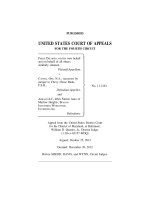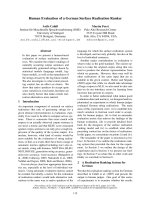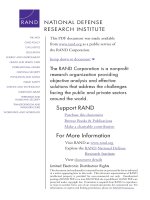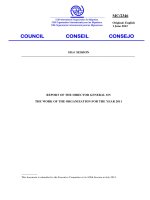EVALUATION OF DEMAND FOR INTERDEPENDENT INFRASTRUCTURE INVESTMENTS doc
Bạn đang xem bản rút gọn của tài liệu. Xem và tải ngay bản đầy đủ của tài liệu tại đây (802.96 KB, 156 trang )
Industrial and Financial Economics
Master Thesis No 2003:37
EVALUATION OF DEMAND FOR INTERDEPENDENT
INFRASTRUCTURE INVESTMENTS
- THE CASE OF THE GÖTA ÄLV VALLEY
Anneli Axsäter & Anna Boström
Graduate Business School
School of Economics and Commercial Law
Göteborg University
ISSN 1403-851X
Printed by Elanders Novum
ABSTRACT
Our thesis aimed to describe the demand for transportation between Göteborg
and Trollhättan in such a way that it could be used for decision making.
Furthermore, we aimed to draw parallels between Norge/Vänernbanan and
Svealandsbanan. Finally, we wanted to decide if investments should be made in
R45, in Norge/Vänernbanan, or in both. A survey among commuters in the area
between Göteborg and Trollhättan was performed and company interviews
with companies in the municipalities of Göteborg, Ale, Lilla Edet, and
Trollhättan were conducted. Furthermore, we explained how scenario analysis
can be applied within the field of transportation when determining how an
increased capacity affects the demand for transportation and how the demand
affects the payoff of infrastructure investments. From our survey and
interviews, we can conclude that transfer effects may be realized if investments
in R45 and in Norge/Vänernbanan are made. Companies in the area demand
infrastructure investments because of recruiting and commuting problems. We
suggest expanding R45 into four lanes with a railing in the middle and
intersections below or above the road, to increase the bus frequency, and to
investigate whether it is possible to increase the train frequency and/or
investing in high-speed trains while keeping the current track capacity.
Key Words:
Infrastructure investment, elasticity, cross elasticity, transfer effect,
“generalized cost”, consumer surplus, transport modeling, Limdep, Sampers,
nettonuvärdeskvot, multinomial logit model.
ACKNOWLEDGEMENTS
The completion of this thesis has been possible through the assistance of a
number of people. First of all, we would like to thank Professor Göran
Bergendahl, who has been very supportive and encouraging throughout this
period of thesis writing. He has provided us with valuable insights within the
field of transportation and has pushed us in the right direction through a lot of
knowledge within the area and also through his creative ideas. Bengt
Wennerberg at Business Region Göteborg is to be thanked for raising our
interest in infrastructure investments and for introducing us to infrastructure
investments in R45 and Norge/Vänernbanan. Our survey would not have been
possible without advice and help from Fredrik Carlsson, a doctoral student at
the Department of Economics at the School of Economics and Commercial
Law, Göteborg University, Karl. O. Olsson, a doctoral student at the
Department of Business Administration at the School of Economics and
Commercial Law, Göteborg University, the traffic police in
Västragötalandsregionen, and all car, train, and bus commuters who responded
to our questionnaire. Fredrik Carlsson introduced us to the software program
Limdep and gave us valuable advice when constructing our questionnaire. Karl
O. Olsson gave us suggestions for relevant literature within the area. The help
from the traffic police was tremendously important to us since, through their
help, we were able to distribute our questionnaire to car commuters on R45.
Furthermore, we greatly appreciate the policemen’s positive attitude when
helping us. The time and effort that car, train, and bus commuters put into our
questionnaire while filling it out resulted in an interesting analysis, which could
not have been completed without their assistance. We also would like to thank
the representatives at AB Volvo, Eka Chemicals AB, SAAB, SCA, SKF, Volvo
Aero, and Volvo Car Corporation for taking their time to answer our questions.
Lastly, we take this opportunity to thank Helena Braun at SIKA and Tomas
Hultgren at Västsvenska Industri- och Handelskammaren who both showed a
great interest in and enthusiasm over our findings.
Göteborg, December 2003
Anneli Axsäter & Anna Boström
TABLE OF CONTENTS
1 BACKGROUND 1 -
1.1 Infrastructure Investments and Users’ Benefits 1 -
1.1.1 Introduction 1 -
1.1.2 Infrastructure Investments and Region Enlargement 3 -
1.2 Demand for Transports 5 -
1.2.1 Relationship between “Generalized Cost” and Consumer Surplus 7 -
1.3 R45 and Norge/Vänernbanan 9 -
1.3.1 The Göta Älv Valley 9 -
1.3.2 Characteristics of R45 and of Norge/Vänernbanan 10 -
2 PROBLEM DISCUSSION 13 -
2.1 Purpose 17 -
3 METHODOLOGY 19 -
3.1 Working Process 19 -
3.2 Quantitative Approach 20 -
3.2.1 Travel Demand Models 20 -
3.2.2 Usage of Multinomial Logit Model in Survey Analysis 25 -
3.2.3 Survey Sample 26 -
3.2.4 Choice of Survey Method 27 -
3.2.5 Stated Preference Experiment 29 -
3.2.6 Development of the Questionnaire 33 -
3.2.7 Data collected through Survey 34 -
3.2.8 Sources of Errors when collecting Data for a Stated Preference Experiment 36 -
3.2.9 Choice of Variables in Limdep and their Significance 38 -
3.2.10 Descriptive Statistical Approach 41 -
3.2.11 Additional Approach 41 -
3.3 Qualitative Approach 41 -
3.3.1 Interview Sample 41 -
3.3.2 Interview Guide 42 -
3.4 Comparative Approach 42 -
3.5 Validity and Reliability of Our Survey and Interviews 43 -
3.5.1 Validity - 43 -
3.5.2 Reliability - 44 -
4 SURVEY AND INTERVIEW RESULTS 47 -
4.1 Results from Survey 47 -
4.1.1 Results from Descriptive Statistical Approach - 47 -
4.1.2 Results from Multinomial Logit Model - 58 -
4.2 Interview Results 60 -
5 EVOLUTION OF DEMAND FOR TRANSPORTATION BETWEEN
GÖTEBORG AND TROLLHÄTTAN 65 -
5.1 Current Demand Forecasting Model: Sampers 65 -
5.1.1 The Nested Logit Model and Potential Weaknesses - 66 -
5.2 Elasticities obtained through Multinomial Logit Model 69 -
5.3 Effects on Demand of Changes in Traveling Time 70 -
5.3.1 Elasticity among Car Commuters - 71 -
5.3.2 Elasticity among Bus Commuters - 73 -
5.3.3 Elasticity among Train Commuters - 75 -
5.4 Effects on Demand of Changes in Mode Frequency 76 -
5.4.1 Elasticity among Bus Commuters - 77 -
5.4.2 Elasticity among Train Commuters - 78 -
5.5 Company Interviews 79 -
5.5.1 Recruiting and Employee Commuting - 79 -
5.5.2 Freight Transports - 81 -
5.5.3 Choice of Transportation Mode - 83 -
5.5.4 Future Strategies - 84 -
5.6 Scenario Analysis 84 -
5.7 Concluding Discussion 88 -
6 INVESTMENT IN R45 & NORGE/VÄNERNBANAN 91 -
6.1 Underestimation of Costs in Infrastructure Investments 91 -
6.2 Suggestions for Investments in R45 and in Norge/Vänernbanan 92 -
6.2.1 Current Investment Plan for R45 and Norge/Vänernbanan - 92 -
6.2.2 Investment in R45 and in Norge/Vänernbanan 93 -
6.3 Comparison between Norge/Vänernbanan and Svealandsbanan 98 -
6.4 Concluding Discussion 100 -
7 CONCLUSION 105 -
8 RECOMMENDATIONS FOR FURTHER RESEARCH 109 -
9 REFERENCE LIST 111 -
APPENDIX I I
APPENDIX II III
APPENDIX III IX
APPENDIX IV XIII
APPENDIX V XVII
APPENDIX VI XXI
APPENDIX VII XXIII
APPENDIX VIII XXV
APPENDIX IX XXVII
- 1 -
1 BACKGROUND
1.1 Infrastructure Investments and Users’ Benefits
1.1.1 Introduction
Many countries regard infrastructure as being a critical success factor for
internationalization and for regional development. These countries also regard
missing links or missing networks in the infrastructure as factors that could
reduce the productivity in a region significantly
1
. Improved networks in the
infrastructure may improve the accessibility within a region, since the number
of workplaces that can be reached in a certain time increases through an
investment. Infrastructure investments usually result in the largest effects in
areas where the economic growth is restricted by limited accessibility.
Usually, infrastructure investments involve high investment costs. The positive
effects, such as increased accessibility, that may be obtained through an
infrastructure investment must be considered in relation to the high investment
cost. In Sweden, one uses a measure called the “nettonuvärdeskvot” (NNK) in
order to take account of different factors, such as the future development and
possible changes of the population, economy, and the business world, that may
affect the cost and the social surplus
2
of an infrastructure investment. The NNK
is calculated as benefits minus costs and then this value is divided by the
investment cost. The value received is the utility per invested SEK by
incorporating an investment within a limited investment budget
3
.
The NNK is the measure used by Banverket (the Swedish National Rail
Administration), Vägverket (the Swedish National Road Administration), and
by the government in Sweden when valuing infrastructure investments. The
government decides which infrastructure investments that should be
undertaken. However, Vägverket is responsible for the planning and
administration of road investments and Banverket is responsible for the
planning and administration of railway investments. Other investments than the
actual building of a road or a railway, such as the investment in high-speed
1
Polak & Heertje (2000)
2
Social surplus is the surplus or benefits enjoyed by society as a whole.
3
Bergendahl (2002)
- 2 -
trains or the investment in an increased bus or train frequency, are usually
administered by Statens Järnvägar (SJ) and local public transportation
companies, such as Västtrafik.
In principle, one should undertake all infrastructure investments that have a
positive NNK, but due to the fact that infrastructure investments normally are
very expensive, the government is not able to undertake all these investments.
Therefore, the NNK is used to enable the government to rank and to prioritize
different infrastructure investments. Accordingly, the NNK can be applied to
all infrastructure investments in Sweden and thereby one quite easily is able to
compare these investments with each other. However, one weakness with the
current way of comparing and deciding between different investments is the
fact that it is very difficult to prioritize between integrated investments, which
are interdependent, and independent investments
4
.
This thesis will evaluate the demand for road 45 (R45) and for
Norge/Vänernbanan between Göteborg and Trollhättan, which is one example
of integrated infrastructure investments. Currently, R45 and
Norge/Vänernbanan mainly act as a transport corridor between these two cities
and constitute an important link between Göteborg and Trollhättan. Since R45
and Norge/Vänernbanan run parallel, between Göteborg and Trollhättan, an
investment in either the road or the railway would probably affect the demand
for both the road and the railway. That is, the demand for the road and for the
railway would probably change, which could result in transfer effects between
different modes of transportation. The importance of transfer effects is one
reason why one should evaluate interdependent investments and independent
projects differently.
The current national model used by Vägverket, Banverket, and SIKA (Statens
Institut för Kommunikationsanalys) when estimating the demand for
infrastructure investments is a model called Sampers. The results obtained from
Sampers are included in the NNK in order to capture demand effects. It has
been discovered that Sampers produces transfer effects, i.e. cross elasticities,
4
Bergendahl (2002)
- 3 -
that seem to be too low
5
. This means that one has difficulties in accurately
estimating the demand for two interdependent infrastructure investments. If one
is not able to estimate the demand in an accurate way, the true effects and
payoff of an infrastructure investment for different regions can be misjudged.
In the worst case, a misjudgement could lead to an investment that does not pay
off since the true demand for the investment is too low.
1.1.2 Infrastructure Investments and Region Enlargement
If the estimation of the demand for transportation reflects the true demand, the
probability of choosing an investment solution that will contribute to economic
growth and region enlargement increases. A region can be a whole country or
just a specific part of a country. A region can also be characterized by the
extent that a specific market, such as the working force, can be extended to
other areas. In a functional region, the working force is integrated and the
possibility of quick personal contact is large, which enables different industries
and companies to more easily cooperate. The size and enlargement of a region
depend on the number of companies, the total number of employees, and the
number of customers in the region. An enlargement can be made possible in
several different ways, such as new company establishments or an improved
infrastructure. In a region where the infrastructure is relatively efficient, an
infrastructure improvement probably will have less effect than in another
region where the current infrastructure is less efficient. Additionally, improved
infrastructure and transport opportunities usually have a larger effect on regions
with large populations, large market potential, and where the capacity of the
infrastructure is used to a larger extent than in other regions
6
. However, in
weak regions other factors than infrastructure improvements may be more
important and have a larger effect on the society. In these weak regions it may,
for example, be more beneficial to the area to increase the level of education
among the inhabitants. An infrastructure improvement in a weak region can
have a negative effect since the existing local business industry may be driven
out of competition by companies situated outside the local industry, which now
have access to the local industry through the infrastructure improvement
7
.
5
Helena Braun (071103)
6
Johansson & Klaesson (2003)
7
Fröidh (2003)
- 4 -
The frequency of commuting trips between different municipalities is usually
related to the quality of the infrastructure in a specific area. An infrastructure
improvement that facilitates the commuting within the region can make people
start considering working for companies that seemed unreasonably distant
before the infrastructure improvement was made. For example, if investments
were undertaken in R45 and in Norge/Vänernbanan, people living in Göteborg
would probably find it more attractive to commute to Trollhättan than they
currently do. An infrastructure improvement could also enable companies to
reach a larger number of customers. It has been analyzed to which extent
people tend to want to travel when the traveling time changes. The traveling
time affects the demand for transportation in a non-linear way. The analysis
showed that people whose traveling time is between 15-45 minutes are more
strongly affected by traveling time changes than people whose traveling time
lies outside this interval
8
.
In Sweden, SCB (Statistiska Centralbyrån) and NUTEK (Verket för
Näringslivsutveckling) continuously divide the Swedish municipalities into
“lokala arbetsmarknadsregioner (LA-regioner)”, which can be translated as
local working force regions (LA-regions). A LA-region can be defined as a
coherent area that consists of one or several municipalities based on the amount
of commuting over the borders in relation to the total number of employed
persons within the municipalities
9
. Over time, the number of LA-regions in
Sweden has decreased and their sizes have increased, which proves that the
Swedish working force has become more and more integrated. This process is
called region enlargement.
A larger region increases the probability for good matching between employers
and households in the working force market. The households are faced with
more jobs to choose from and the employers can choose their employees from a
larger number of people and thereby the probability of finding the right
employees increases. Furthermore, companies in a larger region can more
8
Johansson & Klaesson (2003)
9
Fröidh (2003)
- 5 -
easily use and enjoy economies of scale, which increases the overall
productivity and contributes to economic growth
10
.
The sizes of the existing LA-regions in Sweden vary significantly. In other
words, the basic conditions and growth opportunities in the different LA-
regions are completely different. The figure below presents a comparison
among the sizes of the existing 100 LA-regions in Sweden:
Size
Source: Johansson & Klaesson (2003)
Figure 1.2
Source: Johansson & Klaesson (2003)
Figure 1.1
According to Börje Johansson and Johan Klaesson, one can decrease the
differences between different regions in the southern part of Sweden through
good infrastructure and new transport opportunities
11
. In the northern part of
Sweden, however, infrastructure and the transport sector cannot contribute to
region enlargement in the same way as in the southern part of the country
because in the northern part the regions are very small and the distances
between them are very large.
1.2 Demand for Transports
Demand for transportation can be expected to increase with economic
development. The demand for transport services tends to be complementary to
the demand for other goods and services. Therefore, demand for transportation
is normally regarded as a derived demand. A derived demand for transportation
means that the transportation is not needed for its own sake; instead the
transportation is demanded in order to satisfy other needs. However, demand
for transportation such as pleasure trips and cruises could not be regarded as a
derived demand. It is difficult to determine the distribution between the
10
Johansson & Klaesson (2003)
11
IBID
- 6 -
proportion of transportation that results from a derived demand and the
proportion that takes place for its own sake. The existing investment strategies
for infrastructure further explain the complexity of demand for transportation.
When investing in infrastructure one could either expand through a passive
strategy or by an active strategy. An active strategy means that the society uses
the infrastructure as a generator for regional and national development. This
strategy involves a certain degree of risk taking since it assumes a response
from the private sector in the form of increased investments to succeed
12
. A
passive strategy means that the society invests in infrastructure when the
economy and the demand have grown so much that the existing infrastructure
shows a distinct capacity shortage.
Two typical characteristics of the demand for transportation are its variation
over time and the possibility to make substitutions. The demand for
transportation fluctuates regularly over time. For example, in urban areas the
demand for transports seems to be strongly connected to the regular working
hours at different companies. That is, the demand for transports tends to be
higher in the early morning and in the late afternoon. Another example of how
the demand for transports fluctuates over time is the fluctuation during different
seasons. As mentioned above, the demand for transports fluctuates regularly
over time but one can also observe seasonal peaks. During the summer, the
demand for rail and air services tends to increase since the summer is a typical
holiday season
13
. When going on holiday, people choose between different
kinds of transports and choose the type of transport that fits their specific
purpose. Consequently, when going on holiday people always have the choice
of substitution between different kinds of transports. The possibility of
substitution between different kinds of transports is also a characteristic of the
demand for transportation among people who commute to work over the year.
For example, an employee that usually goes by train to work might start using
the bus instead if the bus services change so that the bus seems more desirable
for this specific employee than the train that the employee normally uses.
However, substitution between different transportation modes involves costs of
different kinds, both for the individual commuter, the company providing
12
Fröidh (2003)
13
Button (1993)
- 7 -
public transportation, and for the owners of the infrastructure. For example, if a
train commuter was to substitute the train alternative with the car alternative,
the commuter may need to buy a car first. Another example may be the
increased cost facing a bus company when it needs to buy more buses because
of an increased demand for the bus alternative. Both the variation over time in
the demand for transportation and the opportunity to substitute one mode for
another are factors that affect the balance between the supply and the demand
in the transportation sector.
1.2.1 Relationship between “Generalized Cost” and Consumer Surplus
Transportation and travel take place on a market that is significantly different
from the ideal market model where a well-defined good has a price defined
according to an equilibrium between supply and demand. Equilibrium in the
ideal market model exists when all individuals have made the best possible
choices in the light of their preferences and information and when all these
choices have been coordinated and made compatible with each other. The
equilibrium price is the price where the quantity demanded equals the quantity
supplied. When dealing with supply and demand in the transport sector, the
equilibrium condition is more complicated since one has to consider the fact
that in addition to costing money, traveling also “costs” time. Therefore, the
transport market usually deals with a “generalized cost” where the “cost” of
time is included. In its simplest form, a “generalized cost” is a linear
combination of time and cost, where time is converted to money by evaluating
the value of traveling time savings. However, in larger contexts the
“generalized cost” can include other variables as well that may affect the
traveling decisions by individuals. Thereby, the “generalized cost” can be seen
as a reflection of indirect utility. The supply relationships in the field of
transportation often are focused on the non-monetary variables since these
variables seem to affect the demand for transportation in a major way. The
demand for transportation more often is concerned with the performance of the
transport system than with the monetary costs involved. For example, the
demand for a specific road can be affected by a high degree of congestion or
perhaps a large number of accidents. Accordingly, in the field of transportation
both the demand and the supply are related to the “generalized cost”
14
. The
14
Hensher & Button (2000)
- 8 -
graph below shows the relationship between the supply and the demand in the
transportation sector if the supply changes through an infrastructure
investment:
Source: www.internationalecon.com (271103)
Graph 1.1
The graph shows how an improved infrastructure would affect the “generalized
cost”. An improved infrastructure increases the capacity of the road or railway
in question and hence the supply curve shifts to the right (from S
1
to S
2
). This
type of shift in the supply curve results in a reduced “generalized cost”, that is,
the cost is reduced from GC
1
to GC
2
. The reduction in the “generalized cost”
may depend on a reduced traveling time, which has become possible through
an improved infrastructure. Through an increased supply, the travelers’
consumer surplus increases. Consumer surplus can be defined as the difference
between what the travelers are willing to pay for transportation and the price
that the travelers actually have to pay to use the road or railway. The consumer
surplus is represented by the area A in the graph above before the infrastructure
investment is undertaken. If an infrastructure investment is undertaken, the
consumer surplus increases. The new consumer surplus can be found in the
graph as area A + area B + area C. However, the total consumer surplus is
divided between different travelers. The travelers who were willing to pay GC
1
for transportation now have a consumer surplus that equals area A + area B.
S
1
S
2
A
C
GC
1
GC
2
D
Q
1
Q
2
Q
B
Generalized cost
- 9 -
The remaining part of the consumer surplus, that is area C, belongs to those
travelers who were not willing to travel at the price of GC
1
but only at the new
price of GC
2
15
.
1.3 R45 and Norge/Vänernbanan
1.3.1 The Göta Älv Valley
R45 and Norge/Vänernbanan run parallel to the Göta Älv. Between Göteborg
and Trollhättan the road and railway go through two other municipalities,
which are Ale and Lilla Edet municipalities. Göteborg is the largest
municipality of these four and has a population of about 500,000, Trollhättan is
the second largest with about 50,000 inhabitants and Ale is the third largest
with approximately 25,000 people living in the area. The municipality of Lilla
Edet is the smallest and has a population of 13,000. From 1950 until today one
can see a slow increase in population in the municipalities of Göteborg,
Trollhättan and Ale. Lilla Edet municipality, on the other hand, experienced a
slow decrease in its population during the years 1950-1960 and then a slow
increase in its population until year 2000 when the population started to
decrease again. Over a period of five years (1996-2000), one can conclude that,
on average, the municipalities of Ale and Lilla Edet have had negative patterns
of migration whereas Göteborg and Trollhättan have had positive patterns of
migration. Currently, 656 companies are registered in Ale, 13,717 in Göteborg,
323 in Lilla Edet and 1,033 in Trollhättan.
16
Table 1.1 presents the five largest
companies, in terms of the number of employees, in each municipality.
15
www.internationalecon.com (271103)
16
www.foretagsfakta.se (030901)
- 10 -
Ale Municipality
Göteborg
Municipality
Lilla Edet
Municipality
Trollhättan
Municipality
Eka Chemicals AB,
Bohus
800 employees
AB Volvo
25,400 employees
SCA Hygiene
Products, Edet Bruk,
Lilla Edet
500 employees
SAAB Automobile
7,600 employees
Kraftelektronik AB,
Surte
100 employees
Volvo Car
Corporation
27,380 employees
Solhaga By AB,
Lödöse
170 employees
Volvo Aero
Corporation
4,500 employees
Tekniska Förvaltningen,
Alafors
90 employees
Trelleborg
Automotive AB
9,600 employees
Electrolux Filter AB,
Nygård
120 employees
EDS
1,200 employees
Göteborgs Spårvägar
AB, Älvängen
60 employees
Sodhexo AB
8,500 employees
Knauf Danqlips
GmbH Inlands
kartongbruk
100 employees
Lear Corporation AB
800 employees
SGS-Scandinavian
Garment Service,
Älvängen
50 employees
Gunnebo AB
8,200 employees
Lilla Edets Industri &
Fastighets AB, Lilla
Edet
46 employees
Högskolan i
Trollhättan/Uddevalla
470 employees
Source: www.foretagsfakta.se (201103)
Table 1.1
1.3.2 Characteristics of R45 and of Norge/Vänernbanan
Road 45 (R45) stretches from the southern part of Italy to Nordkap, which is
located in the northern part of Norway. The section of R45 that goes through
Sweden is a part of the Swedish national road system. R45 is an important
regional as well as an important national road. The traffic on R45 is often dense
and is sometimes also flooded because of its location close to the Göta Älv.
From Göteborg north to Nödinge, the road has two lanes in each direction, but
further north there is only one lane in each direction. The road accessibility is
considered as rather bad and therefore the Swedish government has decided
that R45 should be reconstructed and improved. The major reasons for
reconstruction and improvement of the road are to increase its capacity and to
reduce the number of accidents on the road
17
. In comparison with many other
roads in Sweden, there are significantly more accidents on R45. For example,
during 1994-1998 there were on average 80 accidents per year on E6 between
Uddevalla and the Norwegian border, whereas the average number of accidents
on R45 between Göteborg and Trollhättan amounted to 191. It is worth
noticing in this comparison that there are about 111 kilometers between
Uddevalla and the Norwegian border but only 80 kilometers between Göteborg
and Trollhättan
18
.
17
Banverket, Ale kommun & Vägverket (2002)
18
Västsvenska Industri- och Handelskammaren (1999)
- 11 -
North of Göteborg, R45 runs parallel to a railway line called
Norge/Vänernbanan. This line starts in Göteborg and ends in Erikstad. In
Erikstad, Norgebanan turns west and ends in Kornsjo in Norway, whereas
Vänernbanan continues further north in Sweden and ends in Karlstad.
Norge/Vänernbanan is one of the most frequently used single-track railways in
Sweden and is used for both national and international transports of people and
goods. Currently, the railway does not have any stops between Göteborg and
Trollhättan.
Source: Västsvenska Industri- och Handelskammaren Rapport nr 2003:5
Figure 1.2
In the current plan for R45 and Norge/Vänernbanan, the government aims to
invest in both the road and the railway. The government’s plan involves an
expansion of R45 into a four-lane road with a railing in the middle and
intersections below or above R45. Regarding Norge/Vänernbanan, the
government is planning to expand it into double tracks and to offer high-speed
- 12 -
train services. Furthermore, the plan involves investments in six train stations
in Ale municipality
19
. The government aims to realize the investments in
Norge/Vänernbanan in year 2008 at the earliest and in 2011 at the latest. The
improvements to R45 have been postponed and will be realized sometime after
year 2012.
Similar Infrastructure Investments in Sweden
To undertake infrastructure investments where an important road and railway
run parallel to each other is rather unusual in Sweden
20
. The planned
investments in R45 and in Norge/Vänernbanan are one such case. According to
Fröidh, there are mainly three other such cases in Sweden that are comparable
to R45 and Norge/Vänernbanan
21
. These cases are Västkustbanan and E6,
Botniabanan and E4, and Svealandsbanan and E20. Västkustbanan runs
between Malmö and Göteborg, but to study a similar distance that is
comparable to the distance between Göteborg and Trollhättan, one could look
at the section of Västkustbanan that goes between Lund and Helsingborg. This
section has been divided into three different subsections, which are Lund-
Kävlinge, Kävlinge-Landskrona, and Landskrona-Helsingborg. The investment
plan is to build double tracks in all of these three subsections and also to invest
in five train stations in total. Currently, double tracks exist between Kävlinge
and Helsingborg whereas the investment in double tracks between Lund and
Kävlinge will be completed in 2005. The goal with the investments between
Lund and Helsingborg is to facilitate the commuting
22
. Botniabanan will be a
single-track railway that will go between Nyland, in the municipality of
Kramfors, and Umeå. The building of Botniabanan started in 1999 and is
planned to be completed in 2008. Svealandsbanan was opened for traffic in
1997 and goes between Eskilstuna and Södertälje. In Södertälje, one can easily
take the Grödinge Line to Stockholm. Svealandsbanan is partly a double-track
railway and it includes five train stations between Eskilstuna and Stockholm.
19
www.vv.se (191103)
20
Oskar Fröidh (091203)
21
IBID
22
www.banverket.se (101203)
- 13 -
2 PROBLEM DISCUSSION
Sampers, the current national demand forecasting model for passenger
transportation, was developed in 1999 by SIKA. The results obtained in
Sampers are included in the NNK. The Sampers forecasting model can be used
as a basis when measuring factors such as demand effects of new infrastructure
and new transports supply, demand effects of changing factors, and regional
effects
23
.
SAMPERS
• Commissioned by SIKA in 1999
• Forecasts the demand for passenger transportation
• Four-stage model, which also can be called an assignment model
• Four steps to calculate the demand: Trip generation, trip distribution, modal split, and route choice
• Can among other factors measure demand effects of new infrastructure, accessibility effects, regional
effects, and demand effects of changing socio-economic factors
• One national model, five regional models, and one international model
The Sampers forecasting model has a number of weaknesses, which may affect
the results and consequently the NNK in an undesirable way. A recent
discovered weakness with Sampers is that it does not consider transfer effects
between different modes of transportation in an appropriate way
24
. This
weakness plays a major role when evaluating two interdependent infrastructure
investments simultaneously, which is the case with R45 and
Norge/Vänernbanan. One must analyze which factors, such as traveling time,
comfort, and mode frequency, affect different types of commuters and to what
extent these groups are affected by changes in these factors. If one cannot
measure and describe the demand for transportation appropriately and
determine possible transfer effects between different modes, it is very difficult
to determine the true effect that the demand for transportation has on the payoff
from an infrastructure investment.
23
Fröidh (2003)
24
Helena Braun (071103)
- 14 -
A new infrastructure investment can be viewed differently by individuals,
companies, and by society. Individuals’ demands for a new road or a new
railway depend on whether the investment means new or improved ways for
them to get to their current work, opportunities to reach new job areas, or
perhaps the attraction to new and different vacation areas. Companies can
experience opportunities to expand their business, which could involve more
products or new employees, through a new infrastructure investment.
Furthermore, infrastructure investments can also lead to economic growth and
social surplus. Usually, the regional development in the areas around the
investment will be difficult to see in the first few years after the investment has
been made. The fact is that the regional development depends on the demand
for transportation among the individuals and the companies in the area where
an infrastructure investment has been made. The discussion above results in the
following research questions:
a) How can one estimate and describe the evolution of demand for
transportation in such a way that it could be used for decision-making?
b) How does the demand for transportation affect the payoff of the
infrastructure investment?
c) Which effect will an increased capacity have on the demand and how can
one evaluate an expanded traffic?
The research questions stated above are especially interesting when considering
the weaknesses in Sampers. Sampers is not able to accurately capture transfer
effects between different modes of transportation since the model estimates the
demand for road transportation and for rail transportation separately. Therefore,
it is important to determine if there are alternative ways of measuring these
transfer effects. Transfer effects are also interesting to study since R45 and
Norge/Vänernbanan are interdependent investment projects. Accordingly, an
increased capacity in either the road or the railway may affect the demand for
both the road and the railway.
When planning the development for R45 and Norge/Vänernbanan one can
consider different alternatives depending on the demand for transportation in
the area. One could improve both R45 and Norge/Vänernbanan, one could only
- 15 -
invest in the road, or one could only focus on an investment in an improved
railway. Currently, the government is planning to invest in both the road and
the railway. R45 will be expanded into a four-lane road with a railing in the
middle and intersections below or above the road. The current investment plan
for Norge/Vänernbanan is to expand it into double tracks, to build six train
stations in Ale municipality, and to provide high-speed train services
25
.
Whether an investment in the road, in the railway, or in both, is the most
suitable depends on many different factors, but the demand for road traffic, the
demand for railway traffic, and possible transfer effects should play an
important role when making the final decision. Therefore, an additional aim is
to study the following research problem from a demand-oriented perspective:
d) Should an investment in the road, in the railway, or in both, be
undertaken?
Many train stations between Göteborg and Trollhättan would result in a slower
train ride than if only a few stations would be constructed. When trying to find
the optimal investment alternative for Norge/Vänernbanan it is interesting to
make comparisons to similar investments. As discussed in section 1.3.2,
railways that could be compared to Norge/Vänernbanan are Västkustbanan,
Botniabanan, and Svealandsbanan. However, we found it most appropriate to
make a comparison with Svealandsbanan. There are mainly three reasons why
we argue that Svealandsbanan is the most appropriate. Firstly, the construction
of Svealandsbanan is, in comparison to Västkustbanan and Botniabanan,
completely finished. Secondly, even if information is available for all three
railways, the information about Svealandsbanan is more valuable than the
information about the other two railways. This mainly depends on the fact that
Oskar Fröidh at the Royal Institute of Technology (KTH), Stockholm, has
written a doctoral thesis about Svealandsbanan and the effects on demand
through the introduction of high-speed train services. Thirdly, the length of
Svealandsbanan is advantageous in the sense that it is more similar in length to
Norge/Vänernbanan between Göteborg and Trollhättan than the two other
railways are.
25
www.vv.se (191103)









